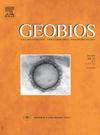Messelornithids and messelornithid-like birds from the early Eocene London Clay of Walton-on-the-Naze (Essex, UK)
IF 1.6
4区 地球科学
Q2 PALEONTOLOGY
引用次数: 0
Abstract
We describe gruiform and gruiform-like birds from the early Eocene London Clay of Walton-on-the-Naze (Essex, UK). One species belongs to the Messelornithidae and is classified as Nasiornis messelornithoides nov. gen., nov. sp.; the coracoid of this species resembles that of Bumbaniralla from the early Eocene of Mongolia. Another possible messelornithid species is tentatively assigned to the poorly known taxon Parvirallus Harrison and Walker, 1979, as ?P. incertus nov. sp. A further species is referred to the taxon Walbeckornis Mayr, 2007, as W. waltonensis nov. sp., and extends the geographical and temporal range of this taxon, which so far was only known from the Paleocene of Germany. Even though similarities between Walbeckornis and messelornithids were previously noted, a plesiomorphic morphology of the quadrate suggests a position of Walbeckornis outside crown group Gruiformes. Furthermore, all fossil taxa described in the present study lack a deeply concave facies articularis alularis (carpometacarpus), which we identify as a previously overlooked apomorphy of crown group Ralloidea. Therefore, resemblances between Walbeckornis and the Messelornithidae, which are the sister taxon of crown group Ralloidea, are likely to be plesiomorphic for a more inclusive clade.
英国埃塞克斯郡沃尔顿-纳兹(Walton-the-Naze)早始新世伦敦粘土中的介壳虫鸟类和类似介壳虫鸟类的鸟类
我们描述了来自英国埃塞克斯郡沃尔顿-纳兹(walton -on- naze)早始新世伦敦粘土的gruiform和类似gruiform的鸟类。1种隶属于密照鸟科,分类为密照鸟(Nasiornis messelornithoides);该物种的喙形与蒙古始新世早期的Bumbaniralla的喙形相似。另一种可能的messselornithid种被暂时分配到鲜为人知的分类单元Parvirallus Harrison和Walker, 1979,作为?P。另一种被称为Walbeckornis Mayr(2007)分类群W. waltonensis nov. sp.,并扩展了该分类群的地理和时间范围,迄今为止该分类群仅在德国古新世被发现。尽管Walbeckornis和messelornithids之间的相似性之前已经被注意到,但方形的半形似形态表明Walbeckornis位于冠群Gruiformes之外。此外,本研究中描述的所有化石分类群都缺乏深凹相articularis alularis (carpometacarpus),我们认为这是冠群Ralloidea中以前被忽视的一种形形。因此,Walbeckornis和Messelornithidae之间的相似性(它们是冠群Ralloidea的姐妹分类单元)可能是一个更具包容性的分支。
本文章由计算机程序翻译,如有差异,请以英文原文为准。
求助全文
约1分钟内获得全文
求助全文
来源期刊

Geobios
地学-古生物学
CiteScore
3.30
自引率
6.20%
发文量
28
审稿时长
6-12 weeks
期刊介绍:
Geobios publishes bimonthly in English original peer-reviewed articles of international interest in any area of paleontology, paleobiology, paleoecology, paleobiogeography, (bio)stratigraphy and biogeochemistry. All taxonomic groups are treated, including microfossils, invertebrates, plants, vertebrates and ichnofossils.
Geobios welcomes descriptive papers based on original material (e.g. large Systematic Paleontology works), as well as more analytically and/or methodologically oriented papers, provided they offer strong and significant biochronological/biostratigraphical, paleobiogeographical, paleobiological and/or phylogenetic new insights and perspectices. A high priority level is given to synchronic and/or diachronic studies based on multi- or inter-disciplinary approaches mixing various fields of Earth and Life Sciences. Works based on extant data are also considered, provided they offer significant insights into geological-time studies.
 求助内容:
求助内容: 应助结果提醒方式:
应助结果提醒方式:


